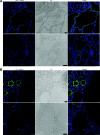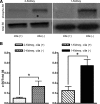Loss of primary cilia upregulates renal hypertrophic signaling and promotes cystogenesis
- PMID: 21493775
- PMCID: PMC3083306
- DOI: 10.1681/ASN.2010050526
Loss of primary cilia upregulates renal hypertrophic signaling and promotes cystogenesis
Abstract
Primary cilia dysfunction alters renal tubular cell proliferation and differentiation and associates with accelerated cyst formation in polycystic kidney disease. However, the mechanism leading from primary ciliary dysfunction to renal cyst formation is unknown. We hypothesize that primary cilia prevent renal cyst formation by suppressing pathologic tubular cell hypertrophy and proliferation. Unilateral nephrectomy initiates tubular cell hypertrophy and proliferation in the contralateral kidney and provides a tool to examine primary cilia regulation of renal hypertrophy. Conditional knockout of the primary cilia ift88 gene leads to delayed, adult-onset renal cystic disease, which provides a window of opportunity to conduct unilateral nephrectomy and examine downstream kinetics of renal hypertrophy and cyst formation. In wild-type animals, unilateral nephrectomy activated the mTOR pathway and produced appropriate structural and functional hypertrophy without renal cyst formation. However, in ift88 conditional knockout animals, unilateral nephrectomy triggered increased renal hypertrophy and accelerated renal cyst formation, leading to renal dysfunction. mTOR signaling also increased compared with wild-type animals, suggesting a mechanistic cascade starting with primary ciliary dysfunction, leading to excessive mTOR signaling and renal hypertrophic signaling and culminating in cyst formation. These data suggest that events initiating hypertrophic signaling, such as structural or functional loss of renal mass, may accelerate progression of adult polycystic kidney disease toward end-stage renal disease.
Copyright © 2011 by the American Society of Nephrology
Figures







Comment in
-
Third-hit signaling in renal cyst formation.J Am Soc Nephrol. 2011 May;22(5):793-5. doi: 10.1681/ASN.2011030284. Epub 2011 Apr 14. J Am Soc Nephrol. 2011. PMID: 21493772 Free PMC article. No abstract available.
References
-
- Guay-Woodford LM: Murine models of polycystic kidney disease: Molecular and therapeutic insights. Am J Physiol Renal Physiol 285: F1034–F1049, 2003 - PubMed
-
- Siroky BJ, Guay-Woodford LM: Renal cystic disease: The role of the primary cilium/centrosome complex in pathogenesis. Adv Chronic Kidney Dis 13: 131–137, 2006 - PubMed
-
- Zhou J: Polycystins and primary cilia: Primers for cell cycle progression. Annu Rev Physiol 71: 83–113, 2009 - PubMed
-
- Cardenas-Rodriguez M, Badano JL: Ciliary biology: Understanding the cellular and genetic basis of human ciliopathies. Am J Med Genet C Semin Med Genet 151: 263–280, 2009 - PubMed
Publication types
MeSH terms
Substances
Grants and funding
- DK35534/DK/NIDDK NIH HHS/United States
- P30 DK074038/DK/NIDDK NIH HHS/United States
- DK065655/DK/NIDDK NIH HHS/United States
- R01 DK032032/DK/NIDDK NIH HHS/United States
- R01 DK065655/DK/NIDDK NIH HHS/United States
- R01 DK061458/DK/NIDDK NIH HHS/United States
- P30 DK079337/DK/NIDDK NIH HHS/United States
- DK32032/DK/NIDDK NIH HHS/United States
- P30 AR 46031/AR/NIAMS NIH HHS/United States
- DK061458/DK/NIDDK NIH HHS/United States
- P30 DK 079337/DK/NIDDK NIH HHS/United States
- P30DK074038/DK/NIDDK NIH HHS/United States
- P30 AR046031/AR/NIAMS NIH HHS/United States
LinkOut - more resources
Full Text Sources
Medical
Molecular Biology Databases
Miscellaneous

